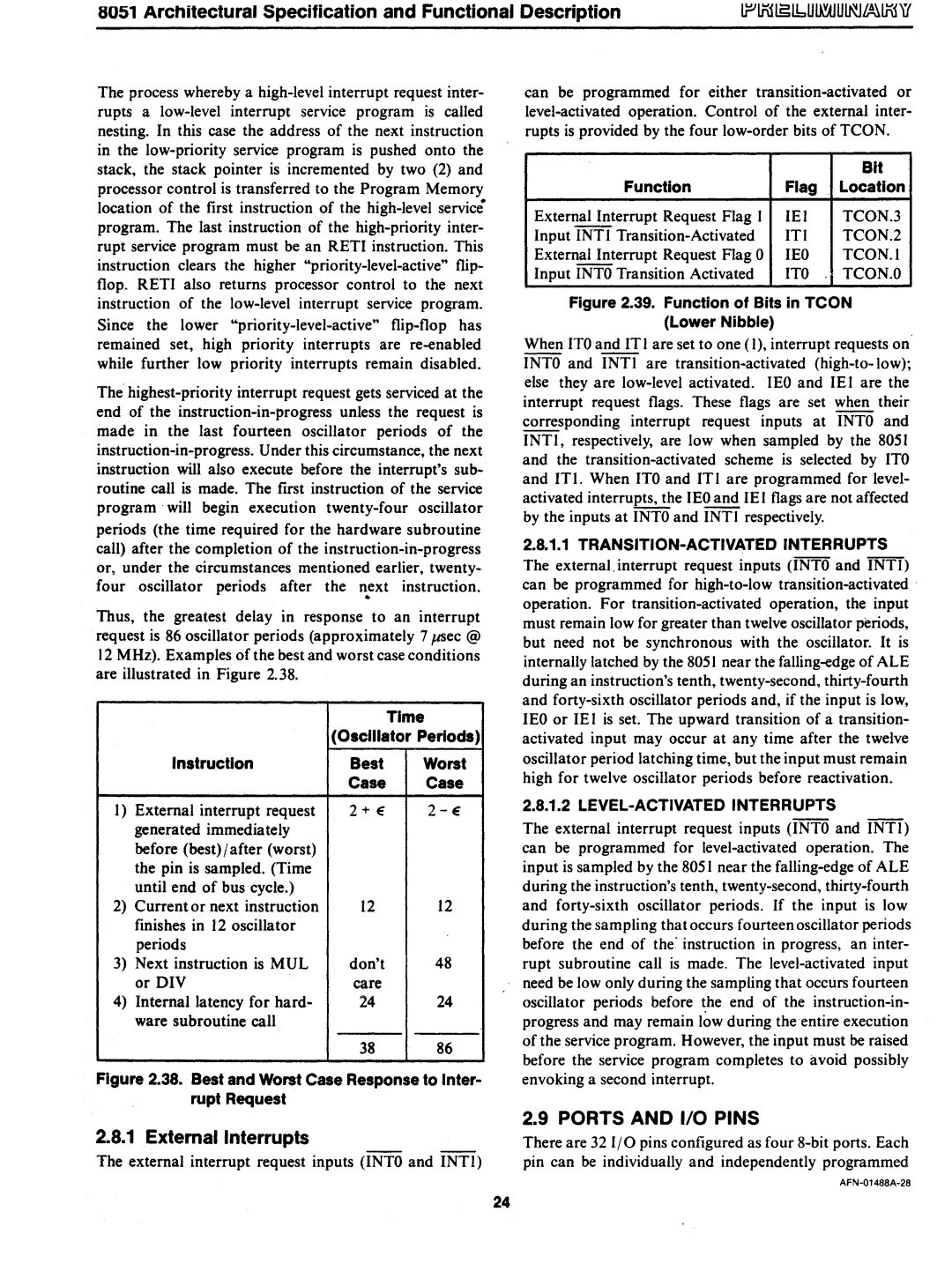The process whereby a high-level interrupt request inter- rupts a low-level interrupt service program is called nesting. In this case the address of the next instruction in the low-priority service program is pushed onto the stack, the stack pointer is incremented by two (2) and processor control is transferred to the Program Memory location of the first instruction of the high-level service program. The last instruction of the high-priority inter- rupt service program must be an RETI instruction. This instruction clears the higher "priority-level-active" flip- flop. RETI also returns processor control to the next instruction of the low-level interrupt service program. Since the lower "priority-level-active" flip-flop has remained set, high priority interrupts are re-enabled while further low priority interrupts remain disabled.
The highest-priority interrupt request gets serviced at the end of the instruction-in-progress unless the request is made in the last fourteen oscillator periods of the instruction-in-progress. Under this circumstance, the next instruction will also execute before the interrupt's sub- routine call is made. The first instruction of the service program will begin execution twenty-four oscillator periods (the time required for the hardware subroutine call) after the completion of the instruction-in-progress or, under the circumstances mentioned earlier, twenty- four oscillator periods after the next. instruction .
Thus, the greatest delay in response to an interrupt request is 86 oscillator periods (approximately 7 f.JSec @ 12 MHz). Examples of the best and worst case conditions are illustrated in Figure 2.38.
| | | Time |
| | (Oscillator Periods) |
| Instruction | Best | Worst |
| | Case | Case |
1) | External interrupt request | 2 + E | 2-E |
| generated immediately | | |
| before (best) / after (worst) | | |
| the pin is sampled. (Time | | |
| until end of bus cycle.) | | |
2) | Current or next instruction | 12 | 12 |
| finishes in 12 oscillator | | |
| periods | | |
3) | Next instruction is MUL | don't | 48 |
| or DIV | care | |
4) | Internal latency for hard- | 24 | 24 |
| ware subroutine call | | |
| | 38 | 86 |
Figure 2.38. Best and Worst Case Response to Inter- rupt Request
can be programmed for either transition-activated or level-activated operation. Control of the external inter- rupts is provided by the four low-order bits of TCON.
| | Bit |
Function | Flag | Location |
External Interrupt Request Flag I | lEI | TCON.3 |
Input INTI Transition-Activated | ITI | TCON.2 |
External Interrupt Request Flag 0 | lEO | TCON.I |
Input INTO Transition Activated | ITO | TCON.O |
Figure 2.39. Function of Bits in TCON (Lower Nibble)
When ITO and IT I are set to one (I), interrupt requests on INTO and INTI are transition-activated (high-to-Iow); else they are low-level activated. lEO and lEI are the interrupt request flags. These flags are set when their ~sponding interrupt request inputs at INTO and INTI, respectively, are low when sampled by the 8051 and the transition-activated scheme is selected by ITO and ITI. When ITO and ITI are programmed for level- activated interrupts, the lEO and IE I flags are not affected by the inputs at INTO and INTI respectively.
2.8.1.1TRANSITION-ACTIVATED INTERRUPTS
The external. interrupt request inputs (INTO and INTI) can be programmed for high-to-Iow transition-activated . operation. For transition-activated operation, the input must remain low for greater than twelve oscillator periods, but need not be synchronous with the oscillator. It is internally latched by the 8051 near the falling-edge of ALE during an instruction's tenth, twenty-second, thirty-fourth and forty-sixth oscillator periods and, if the input is low, lEO or lEI is set. The upward transition of a transition- activated input may occur at any time after the twelve oscillator period latching time, but the input must remain high for twelve oscillator periods before reactivation.
2.8.1.2LEVEL-ACTIVATED INTERRUPTS
The external interrupt request inputs (INTO and INTI) can be programmed for level-activated operation. The input is sampled by the 8051 near the falling-edge of ALE during the instruction's tenth, twenty-second, thirty-fourth and forty-sixth oscillator periods. If the input is low during the sampling that occurs fourteen oscillator periods before the end of the" instruction in progress, an inter- rupt subroutine call is made. The level-activated input need be low only during the sampling that occurs fourteen oscillator periods before the end of the instruction-in- progress and may remain low during the entire execution of the service program. However, the input must be raised before the service program completes to avoid possibly envoking a second interrupt.

